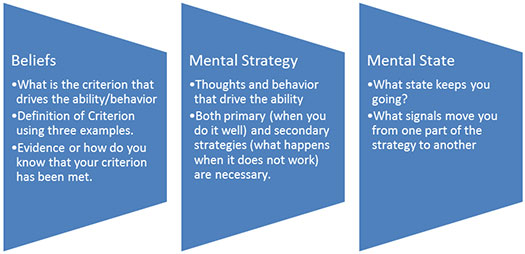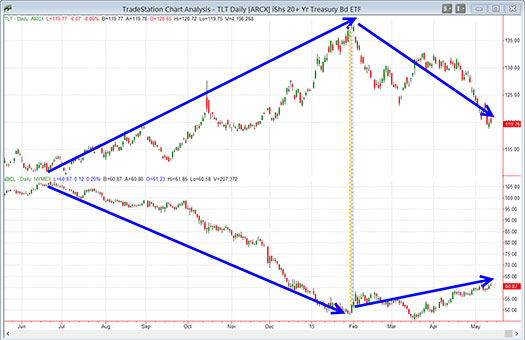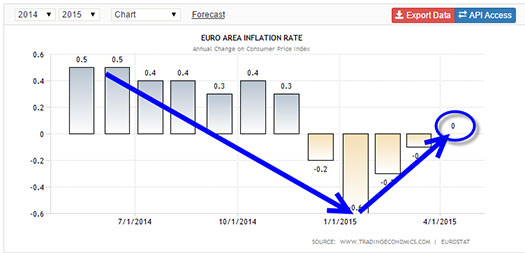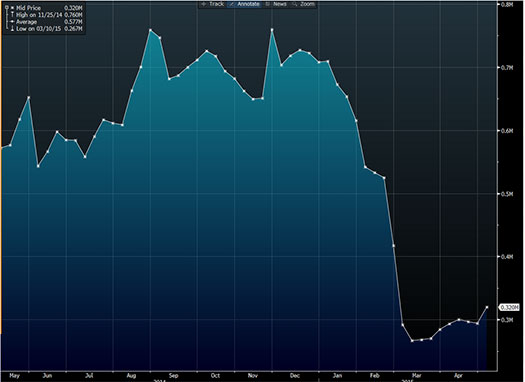Tharp's Thoughts Weekly Newsletter
-
Article: Mental Maps, Models, and Trading Success by Van K. Tharp, Ph.D.
-
Workshops: Oneness Awakening Workshop This June
-
Tip: Bonds Get Bombed by D.R. Barton
-
Join Van Tharp For A Special Oneness Awakening Event
June 13-14, 2015
Participating in the Oneness Awakening Course is an extraordinary opportunity to benefit from some of the important journeys Dr. Tharp has taken to transform his life.
This course has become a fundamental tool in Dr. Tharp's mission to help his clients succeed. Don't miss a chance to learn more about how you can become more aware, positive, calm, centered, and successful!
• Learn about living in the Awakened State of Oneness with joy, freedom from the mind, and release from a sense of separation.
• Learn ancient meditation practices to help open, balance, and clear the chakras (energy centers) and activate energy leading to higher states of consciousness.
• Learn the formula for success and happiness in your inner and outer life, and how to create what you want as your life experience.
• This two-day weekend is a Super Trader qualifying event. If you are interested in the Super Trader Program, you don't want to miss this!
This workshop typically sells out early and is already over half full. Act quickly to secure your seat.
Only $795
Learn More
Feature Article
 Mental Maps, Models, and Trading Success
Mental Maps, Models, and Trading Success
by Van K. Tharp, Ph.D.
View on-line to resolve formatting problems
In my professional career I have two loves. The first has to do with modeling. How do people do what they do? How can I figure out how and why some people perform so far above the crowd? And equally important, how can I teach other people to do that? As I’ve said often, I am a Neurolinguistic Programming Modeler.
My second love is transformation. Our company mission is transformation through a trading metaphor and my life’s work is about making people happier and more evolved as human beings. So the question I really ask is what do certain people do to become both peak performers and exceptional human beings and how can I add those elements to the models use. Let’s take a closer look at modeling.
As one of the early pioneers in Neurolinguistic Programming (NLP), David Gordon described modeling as a process of creating useful maps of human ability. So let’s talk about the idea of mental maps first. In 1931, Alfred Korzybski presented a paper at the American Association for the Advancement of Science in New Orleans in which he made the most famous statement, “The map is not the territory.” He later expanded upon this in his famous book Science and Sanity (1944). Korzybski's purpose was to help people put more precision into language and make their language more exact so that the world within would more closely (sort of) resemble the external world. In other words, he wanted to help make science more exact.
Korzybski’s key principle also became a fundamental presupposition of NLP: The map is not the territory. First, you have a sensory experience — not a sensory experience of the energy that is out there in the world but rather your sense receptors translate and interpret the energy. For example, you see colors because your eyes have cone cells that translate red, green and blue images and then your brain mixes those colors together. The “real world” as we understand it doesn’t have red, green, and blue. Instead, it has light waves at different frequencies and why our brain re-Represents the information to you as various colors. But colors are an interpretation of different wave lengths of light.
But it gets even more complex. What is the “real” world? Well we really have no idea but a good guess is that it is full of “particles and energy and consciousness.” That’s what my map tells me anyway. And the “real” world only exists because “my map” tells me it is out there.
So what is this map that we make to represent the world? Actually, we have many maps and they are really composed of information — or to use a better word, distinctions. Gregory Bateson so famously put it in term of modeling — “What is the distinction that makes the difference?”
I recently watched a video course on modeling by David Gordon who stated that to make useful maps we need a set of distinctions (i.e., rules and guidelines) to make the map making process easy for us. In other words, you even need a model to model others to figure out what their internal maps might be like. What distinctions does Gordon say you need in your modeling map?
| |
• |
First, he says that you need the beliefs that drive the thing you want to model.
|
| |
• |
Second, you need the strategies (a set of internal process and external behaviors) that produce the ability you want to model. There are also probably secondary strategies that come into play when the primary strategy is ineffective. |
| |
• |
Third, you need the mental states that 1) sustain the process of doing what is done and 2) the feelings (or states) that signal whether or not you are on track. |

After reviewing David Gordon’s course, I thought I might try using his mapping process (set of distinctions). Now by this point, I believe I know a lot about successful trading so I decided to model my own knowledge base of the trading process (the 12 tasks of trading).
For any modeling process, you need to get the beliefs first and I’ll focus on that area in the remainder of this article.1 In the beliefs section for a model, you need “the criterion that drives the behavior or strategy.” You also need a definition (description) of the behavior that drives the criterion along with three examples. And finally, you need evidence to know that the criterion has been met.
I started by asking myself about trading success and tried to determine the criterion that I believe drives the whole process. I came up with “follow the rules and make sure you don’t make any mistakes.” In fact, I was really proud of that one because I think most traders think other criteria drive trading success yet following rules without making mistakes is the most vital belief.
Next, you need about three examples to describe or define the criterion. That was easy because I believe there are three types of traders and each approaches this criterion differently - if they know about it.
Example 1, the mechanical trader — The mechanical trader will know that he has followed the rules when he doesn’t interfere in any way with the operation of the system. The rules are all mechanical, so following them is simple — just let the system run and don’t stop any trades from being taken. This doesn’t mean or imply that the rules for the system are necessarily good; it just means that they are followed.
Example 2, the rules based discretionary trader — This trader also has a set of written rules that must be followed and he might allow himself some discretion in interpreting them. Since the rules are clear and written down, however, following them should be easy. For example, one rule might be to never take a trade unless the potential reward is three times as big as the potential risk. His discretion would come into play in determining what the potential reward might be while risk would be defined by his initial stop. With written rules, it’s fairly easy to determine whether or not the rules were followed.
Example 3, the completely discretionary (no rules) trader — This person has no rules and in my opinion, everything he does is a mistake. So again the definition is pretty clear.
Now the next step is to ask people about how they make sure they follow the rules and don’t make any mistakes. There are three specific tasks of trading designed to help here.
First, in the daily self-analysis, you determine that all of your parts who might be involved in the trading process are aligned. If one part is not in agreement, you must do a parts negotiation to get that part into alignment before you start trading. (We cover the tasks of trading and this process in our Peak Performance 101 workshop.) If you don’t complete a daily self-analysis each day before you trade, you could make lots of mistakes repeatedly simply because one of your parts might constantly sabotage the process.
The next task to help you follow your rules is called mental rehearsal - which every professional athlete now does in some form for peak performance. Here you ask yourself, “What might occur today that might prevent me from following my rules?” then generate 1-2 solutions for each, and rehearse those solutions. One of the most common disruptions happens when something shifts your focused mental state into a non-optimal mental state (perhaps information from “talking heads” on the television). In Peak 101 and in the Peak Performance Home Study Course, we teach numerous methods to change your mental state. If you believe your mental state could get shifted, you would mentally rehearse one of these techniques so you can shift quickly back to an optimal state in case it were to happen. After you rehearse an item enough times, the solution becomes automatic, that is your unconscious mind will just do it under the appropriate conditions. (In addition to these daily mental rehearsals, making up a more global or comprehensive scenario list and developing solutions for each is called a worst case contingency plan and this should be a key part of your trading business plan.)
The final trading task to help prevent mistakes is your daily debriefing which happens after your trading is complete. Here you ask yourself, “Did I make any mistakes today?” If you didn’t make any mistakes (i.e., you followed your rules), then pat yourself on the back. If you lost money and followed your rules that day, then pat yourself on the back twice. If you did make a mistake, record the details in your mistake log, then determine the conditions for the cause of the mistake and mentally rehearse the proper response to those conditions. This is a very powerful process and can help you improve your rule following efficiency. For you perfectionists, don’t aim for 95% profitable trades but rather aim for achieving 95% efficiency in your trading — less than one mistake in 20 trades.
So what else would we need for the model at this point? Actually, you would need a lot. First you would have to “chunk down” to look at each of the three tasks in more detail. (Much more specific information for each task’s beliefs, mental states, and mental strategy is well covered in our workshops.) You would also have to “chunk up” and ask “What else is missing?” Here are a few of the other models you would have to develop.
| |
• |
The other nine important tasks of trading, |
| |
• |
How to generate effective trading rules, |
| |
• |
How the rules might differ in different market types, |
| |
• |
Understanding trading objectives and that you achieve your objectives through position sizing, |
| |
• |
Understanding self-sabotage and how to prevent it. |
After you discovered all of the missing pieces, you’d have to model each of those. Now if you were to go through this process fully, you would probably be very impressed with yourself. You would have come up with something very useful, something very helpful. Some of these additional models might be covered in subsequent articles. If you’d like the answers now, however, then I’d suggest you read Trading Beyond the Matrix which covers all of the models for trading success — and gives away the essence of my Super Trader program.
1 I have not included the mental states and mental strategies here for each task because that would double or triple the length of this article.
About the Author: Trading coach and author Van K. Tharp, Ph.D. is widely recognized for his best-selling books and outstanding Peak Performance Home Study Program—a highly regarded classic that is suitable for all levels of traders and investors. You can learn more about Van Tharp at www.vantharp.com. His new book, Trading Beyond The Matrix, is available now at matrix.vantharp.com.
Workshops
Combo Discounts available for all back-to-back workshops!
See our workshop page for details.
Trading Tip

Bonds Get Bombed
by D. R. Barton, Jr.
View on-line to resolve formatting problems
Among retail traders and investors, the bond market is one of the most misunderstood asset classes. Indeed, many traders so concentrate on their stock / futures/ forex world that they don’t know too much of what’s going on in the “fixed” income world.
And most polls of the general public show that the man and women on the street are completely flummoxed by the bond market. “Bond prices go up when yields go down – run that by me again, will ya?” is a common refrain.
So as important as the bond markets (government and corporate) are to the investing world and to global economic endeavors in general, they remain a mystery to many. Perhaps it’s not so surprising why the recent thumping that global bond markets have taken has left many people wondering what happened. Let’s see if we can unwrap the mystery a bit.
What’s Been Driving the Bond Markets?
There are several factors that have converged to take the air out of lofty bond prices. For the sake of brevity, let’s list them and then take a quick look at each:
• Oil price increased, which led to. . . a reduction in the deflation scare
(especially in Europe)
• Too many people crowded into the long bond trade, which led to. . .
unsustainably low yields.
As the dominoes began to fall, bond prices took a tumble — and yields recovered. Let’s look these pairs of related events and how they effected bond prices.
Oil / Deflation
If you need a primer or review of why deflation is a bad thing (very bad) please take a look at this article from last October. In the second half of 2014, global inflation had dropped severely (in lockstep with) the huge decline in oil prices. With that drop in inflation (and a reduction in the perceived future levels of inflation), yields dropped and the price of bonds went up. The link between bond prices and oil prices can be seen clearly when we look at them together:

Click Here to View a Larger Image
The bottom price chart shows oil’s drop from June 2014 until late January of 2015 along with the opposite price action of the U.S. long term bond ETF in the upper chart.
And it would come as little surprise that Europe’s inflation rates mirror this action as well:

Click Here to View a Larger Image
Because this is a bar chart, it’s tough to tell at a glance that the last data point is a zero, so I circled it on the graph. Note how the timing of this chart is right in step with that of the oil price chart above.
Crowded Trade / Low Yields
As traders and investors digested the downward trending oil prices and plummeting inflation moving toward deflationary rates, they piled into the long side of the bond trade. Bloomberg has a great chart showing how crowded this trade had become by the end of last year. The chart below shows how the growing number of long positions in the U.S. Treasury bond futures (reported by the Commodity Futures Trading Commission) affected the yield:

Click Here to View a Larger Image
As more people piled into this trade, yields were driven down. In fact, combined with the negative inflation numbers we saw above, many government bonds yields drifted into negative territory including bonds from Switzerland and Germany. This negative yield environment was simply unsustainable and a bond price drubbing ensued world-wide over the last couple of weeks. By some estimates almost half a trillion dollars of bond value has been wiped out on this drop from the highs.
I hope this broad look at recent bond price drivers was thought provoking. Your views and comments are always welcome - please send them to drbarton “at” vantharp.com — I always enjoy hearing from you!
Great Trading,
D. R.
About the Author: A passion for the systematic approach to the markets and lifelong love of teaching and learning have propelled D.R. Barton, Jr. to the top of the investment and trading arena. He is a regularly featured analyst on Fox Business’ Varney & Co. TV show (catch him most Thursdays between 12:30 and 12:45), on Bloomberg Radio Taking Stock and MarketWatch’s Money Life Show. He is also a frequent guest analyst on CNBC’s Closing Bell, WTOP News Radio in Washington, D.C., and has been a guest on China Central Television — America and Canada’s Business News Network. His articles have appeared on SmartMoney.com MarketWatch.com and Financial Advisor magazine. You may contact D.R. at "drbarton" at "vantharp.com".
Matrix Contest
 Enter the Matrix Contest Enter the Matrix Contest
for a chance to win a free workshop!
We want to hear about the one most profound insight that you got from reading Van's new book, Trading Beyond the Matrix, and how it has impacted your life. If you would like to enter, send an email to [email protected].
If you haven't purchased Trading Beyond the Matrix yet, click here.
For more information about the contest, click here.
Ask Van...
Everything we do here at the Van Tharp Institute is focused on helping you improve as a trader and investor. Consequently, we love to get your feedback, both positive and negative!
Send comments or ask Van a question by clicking here.
Also, Click here to take our quick, 6-question survey.
Back to Top
Contact Us
Email us at [email protected]
The Van Tharp Institute does not support spamming in any way, shape or form. This is a subscription based newsletter.
To change your e-mail Address, e-mail us at [email protected].
To stop your subscription, click on the "unsubscribe" link at the bottom left—hand corner of this email.
How are we doing? Give us your feedback! Click here to take our quick survey.
Call us at: 800-385-4486 * 919-466-0043 * Fax 919-466-0408
SQN® and the System Quality Number® are registered trademarks of the Van Tharp Institute and the International Institute of Trading Mastery, Inc.
Be sure to check us out on Facebook and Twitter!
 
Back to Top |
|
May 13, 2015 #733

Our Mission
Van's Top-Twelve Favorite Trading Books
Van's Favorite Non-Trading Books
Viewing on-line eliminates spacing, and formatting problems that may be unique to your email program.

Ongoing Contest: Learn how you could win a $50 coupon and a grand prize of a free workshop!

"I base my long-term, monthly rebalancing [core] strategies on research into relative strength and momentum as it relates to broad asset classes."-K Long

A Must Read for All Traders
Super Trader
How are we doing?
Give us your feedback!
Click here to take our quick survey.
From our reader survey...
"I think the newsletter is extremely generous and it is a resource I utilize constantly. I have saved every single one since I first subscribed."
Trouble viewing this issue?
View Online. »
Van Tharp You Tube Channel
Tharp Concepts Explained...
-
Trading Psychology
-
System Development
-
Risk and R—Multiples
-
Position Sizing
-
Expectancy
-
Business Planning
Learn the concepts...
Read what Van says about the mission of his training institute.
The Position Sizing Game Version 4.0
Have you figured out yet how to pick the right stocks? Are you still looking for a high win-rate trading system? When you’re ready to get serious about your trader education, download the Position Sizing Game to learn some true fundamentals of trading success. Learn more.
To Download for Free or Upgrade Click Here

Download the first three levels of Version 4.0 for free:
Register now. »
Trouble viewing this issue?
View Online. »

Dr. Tharp is on Facebook

Follow Van through
Twitter »

Check out our home study materials, e-learning courses, and best-selling books.
Click here for products and pricing
What Kind of Trader Are You? Click below to take the test.
Tharp Trader Test
Back to Top

Introduction to Position Sizing™ Strategies
E-Learning Course
Perfect for auditory/visual learners who learn more effectively from an instructional format that is full of interactive features!
Only $149
Learn More
Buy Now
SQN® and the System Quality Number® are registered trademarks of the Van Tharp Institute
|